|
|

This chapter contains hardware installation procedures for the Cisco 1400 series router and includes the following sections:
The Cisco 1400 series router is shipped to you ready for desktop mounting. Before making the power and network connections, simply set the router on a desktop, shelf, or other flat surface.
Be sure to read the safety information in the Regulatory Compliance and Safety Information for the Cisco 1400 Series Routers document that came with your router. It contains translated versions of all the safety warnings that appear in this guide.
 | Warning Read the installation instructions before you connect the system to its power source. |
 | Warning Only trained and qualified personnel should be allowed to install or replace this equipment. |
 | Warning Before working on a chassis or working near power supplies, unplug the power cord on AC units; disconnect the power at the circuit breaker on DC units. |
 | Warning Before working on equipment that is connected to power lines, remove jewelry (including rings, necklaces, and watches). Metal objects will heat up when connected to power and ground and can cause serious burns or weld the metal object to the terminals. |
 | Warning Ultimate disposal of this product should be handled according to all national laws and regulations. |
 | Warning Before opening the chassis, disconnect the telephone-network cables to avoid contact with telephone-network voltages. |
 | Warning Do not work on the system or connect or disconnect cables during periods of lightning activity. |
 | Caution Do not place anything on top of the router that weighs more than 10 pounds (4.5 kg). Excessive weight on top of the router could damage the chassis. |
Most splitters must be installed by the telephone company; however, some splitters can be installed by the customer. If you are not sure what type of splitter to use, contact your service provider.
Figure 2-1 is an example of a type of POTS splitter that is installed at the customer premises by the customer. Other types of POTS splitters are installed by the telephone company on an exterior wall of the customer premises.
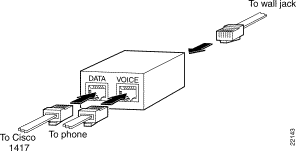
Microfilters are installed on telephones to improve voice-call quality when voice and data equipment are using the same telephone line (twisted pair). You should use microfilters with the Cisco 1407 and Cisco 1417 routers only when the two following conditions exist:
Figure 2-2 shows one type of microfilter.
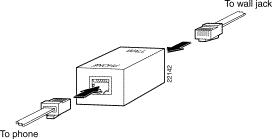
This section describes the most common scenarios using splitters and microfilters with the Cisco 1407 and Cisco 1417 routers. The scenarios are listed from most common to least common.
This scenario is described below and illustrated in Figure 2-2.
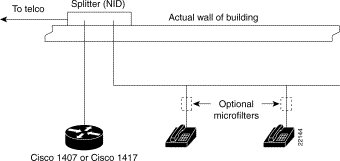
This scenario is described below and illustrated in Figure 2-3.
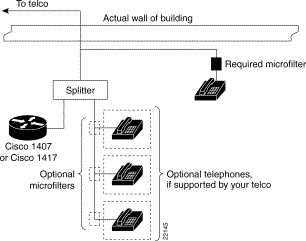
This scenario is described below and illustrated in Figure 2-4.

Follow these steps, and refer to Figure 2-5 to connect the router to the local Ethernet network through the yellow Ethernet port. You must provide a 10BaseT hub or switch to connect the router to the local network.
Step 2 Connect the other end of the cable to a network port on the hub or switch.
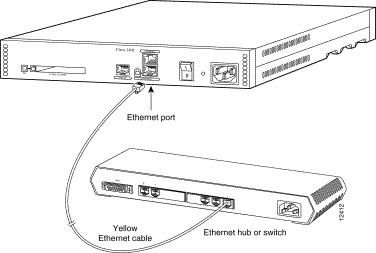
This section describes how to connect the Cisco 1400 series router to the ADSL line. Follow the steps for the router model that you are using.
 | Warning To avoid electric shock, do not connect safety extra-low voltage (SELV) circuits to telephone-network voltage (TNV) circuits. LAN ports contain SELV circuits, and WAN ports contain TNV circuits. Some LAN and WAN ports both use RJ-45 connectors. Use caution when connecting cables. |
 | Warning Hazardous network voltages are present in WAN ports regardless of whether power to the router is OFF or ON. To avoid electric shock, use caution when working near WAN ports. When detaching cables, detach the end away from the router first. |
Follow these steps, and refer to Figure 2-6 to connect the Cisco 1401 router to the ADSL line:
Step 2 Connect the other end of the green cable to the appropriate port on the DSL modem. On the Cisco 625 modem (shown in Figure 2-6), this is the port labeled DATA.
 | Caution Always connect the green ATM cable to the green ATM port. Do not connect the cable to the Ethernet port or to the console port. This will damage your router. |
Step 3 Connect one end of the RJ-11 cable (that you supply) to the ADSL port on the DSL modem. On the Cisco 625 modem, this is the port labeled LINE.
Step 4 Connect the other end of the RJ-11 cable to the ADSL wall jack.
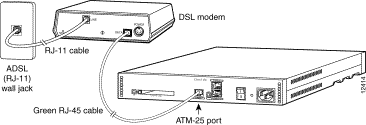
Follow these steps, and refer to Figure 2-7 to connect the Cisco 1407 and Cisco 1417 routers to the ADSL line:
Step 2 Connect the other end of the purple cable to the ADSL wall jack.
 | Caution Always connect the purple ADSL cable to the purple ADSL port. Do not connect the cable to the Ethernet port or to the console port. This will damage your router. |
Step 3 Either install a POTS splitter, or confirm with your service provider that a Telco-installed POTS splitter has been installed. Refer to the "Using POTS Splitters and Microfilters" section earlier in this chapter for details on when to use a splitter.
Step 4 Install microfilters, if needed. Refer to the "Using POTS Splitters and Microfilters" earlier in this chapter for details on when to use microfilters.
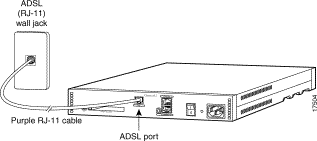
If you want to configure the router using Cisco IOS software, you must connect the console port to a terminal or PC. The cable and adapters required for this connection are included with the router.
Follow these steps, and refer to Figure 2-8 to connect the router to a terminal, terminal server, or PC:
Step 2 Use the correct adapter to connect the other end of the cable to the terminal or PC.

After you turn the router on, you can verify that you correctly installed the router by checking that certain LEDs are lit.
 | Warning This equipment is intended to be grounded. Ensure that the host is connected to earth ground during normal use. |
 | Warning
The power supply is designed to work with TN power systems. |
Follow these steps, and refer to Figure 2-9 to connect the router to power and turn it on:
Step 2 Connect the other end of the power-supply cord to a power outlet.
Step 3 Turn on the router by pressing the power switch to the on ( | ) position.
Step 4 Confirm that the router has power by checking that the PWR LED on the front panel is on.
Step 5 If you are using a DSL modem connected to a Cisco 1401 router, turn on the modem. Refer to the documentation that came with the DSL modem if you are not sure how to turn it on.

You can verify that you have correctly installed the router by checking the following LEDs:
| LED (Location) | What to Look for |
|---|---|
On steady when power is being supplied to the router. | |
OK (front) |
|
ETHERNET ACT (front) | Blinking when there is network traffic on the local Ethernet network. |
On steady when the router is correctly connected to the local Ethernet network through the Ethernet port. | |
WAN CARRIER | On steady when the router has synchronized with the equipment connected to the ATM-25 port (Cisco 1401 router) or with the ADSL equipment at the service provider's central office (Cisco 1407 router). |
On steady when the Flash PC card is correctly installed in the router. If this LED is off, reinstall the card according the following section, "Installing a Flash PC Card." |
The Flash PC card is a writable card used to download new software to the router.
You can perform these steps while the router is operating. Follow these steps, and refer to Figure 2-10 to install the Flash PC card:
When the card is completely seated in the connector, the blue button left of the Flash PC card slot pops out. If the blue button does not pop out, the card is not seated. Press the blue button, remove the card, and reinsert it.
Step 2 Verify that the OK LED (to the left of the card slot) is lit steadily, which indicates that the card is inserted and functioning correctly. If the LED is not on, reinstall the card.
If you cannot successfully install the card, contact your Cisco reseller.
![]()
![]()
![]()
![]()
![]()
![]()
![]()
![]()
Posted: Fri May 25 12:39:47 PDT 2001
All contents are Copyright © 1992--2001 Cisco Systems, Inc. All rights reserved.
Important Notices and Privacy Statement.